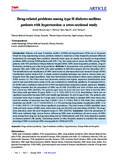| dc.contributor.author | Nzayisenga, J. | |
| dc.contributor.author | Ngomi, Nicholas N. | |
| dc.contributor.author | Nyiligira, J. | |
| dc.date.accessioned | 2021-03-24T13:10:24Z | |
| dc.date.available | 2021-03-24T13:10:24Z | |
| dc.date.issued | 2020-01 | |
| dc.identifier.citation | Life Research, January 2020, Vol. 3 No.1 | en_US |
| dc.identifier.uri | http://197.243.10.178/handle/123456789/6661 | |
| dc.identifier.uri | http://hdl.handle.net/123456789/4561 | |
| dc.description.abstract | Patients with type II diabetes mellitus (T2DM) and hypertension (HTN) are at increased threat for long experiencing various problems related to medicine as they frequently received different medications for managing their condition. Recently, there were no studies done locally on drug-related problems (DRPs) among T2DM patients with HTN. Thus, this study aims to assess the DRPs among T2DM patients with HTN admitted at Kibuye Referral Hospital (KRH). DRPs were drug safety problems, drug ef-fectiveness problems and other drug problems. Methods: A retrospective cross-sectional study involved patients' files with T2DM and HTN, who were admitted at KRH from January 2013 to December 2017. The identification and classification of DRPs were based on pharmaceutical care network Europe (PCNE) classification system version 8.02. A simple random sampling technique was used to choose study par¬ticipants from the target population. Data that met inclusion and exclusion criteria were analyzed using STATA version 13. The Fisher exact test (bivariate analysis) and logistic regression (multivariate) were used to test association and p-value ≤ 0.05 was considered as statistically significant. An adjusted odd ra¬tio (AOR) with a confidence interval (CI) of 95% was determined using binary logistic regression. Results: Findings revealed that the prevalence of DRPs was 81.29% (313/385) and most of them each patient had at least two DRPs (69.05%). The patients aged above 55 years old were more likely to develop DRPs than those with age below 35 years (AOR = 1.2; P = 0.02; 95% CI: 0.2–2.3). Nevertheless, there was no significant association between DRPs and middle age (between 35 and 54 age of old). The patients who consumed more than or equal to 5 drugs were 2.4 times more likely to develop DRPs than those who took the number of medicines less than 5 (AOR = 15.4; P < 0.001; 95% CI: 8.8–26.8). Also, traditional medicines use ((AOR = 1.9; P = 0.016; 95% CI: 1.1–3.5) and having drug-related complication (AOR = 2.4; P < 0.001; 95% CI: 1.9–3) had shown significant associations. The total causes of DRPs identified were 1626 and most causes of DRPs were arisen from drug use (45.01%) and prescribing (37.83%). The drug/ dose selections were the most frequent causes of DRPs (36.97%). Conclusion: Since the prevalence of DRPs were relatively high, various factors influencing DRPs were established and most causes of DRPs were arising from drug use & drug prescribing among T2DM patients with HTN. Early detection needed to enhance patient’s life quality. Conducting studies in other hospitals needed to establish the national planning of DRPs to eradicate DRPs among patients T2DM with HTN. | en_US |
| dc.language.iso | en | en_US |
| dc.subject | Drug-related problems, Type II diabetes mellitus, Hypertension, Kibuye Referral Hospital | en_US |
| dc.title | Drug-related problems among type II diabetes mellitus patients with hypertension: a cross-sectional study | en_US |
| dc.type | Article | en_US |

